
Codium setchellii
Smooth spongy cushion, Green spongy cushion, Green cushion weed
5 June 2023
Botany Bay, Juan de Fuca Strait, B.C., Canada.
Tide: 0.3 feet at 08:53 PDT (measured at Port Renfrew Tidal Station)
Conditions: Clear, light variable winds, sea rippled, moderate westerly swell, humidity 75%, 11˚C.
Moon: Waning Gibbous (96.3%, 17 days); Previous Phase, Full Moon, 3 June 2023 at 8:41pm PDT: Next Phase, Third Quarter, 10 June 2023 at 12:31pm PDT.

Figure 1: In the profusion of life that is pictured here Codium setchellii is one of the characters. The satiny smooth bumpy dark green “blobs” were notable at this site and more abundant this year than we’ve witnessed before. A fascinating green algae, this species is a type of spongy ‘crust’ comprised of tightly packed narrow filaments. There are numerous crusts in our region but none so green and none so spongy and none with such sheen – this sets Codium setchellii truly in a class of its own. Botany Bay, Juan de Fuca Strait, B.C., Canada. June 5, 2023. Photo ID 27591 ©Seaweedwhisperings.com
Person 1:
Shiny, smooth blob.
Smooth to touch as well as visually.
Imposter – sort of looks like a crust.
Can hide by blending in with lookalikes.
Prefers area with overhanging rock.
Spongy to touch.
Easily overlooked; it likes that, so it can go about its devious ways unnoticed.
We rarely find Codium setchellii and it hasn’t previously really called to us for interaction..., there is lots of it here in this surge channel today, thus it and its secrets have been exposed. It’s now vulnerable.
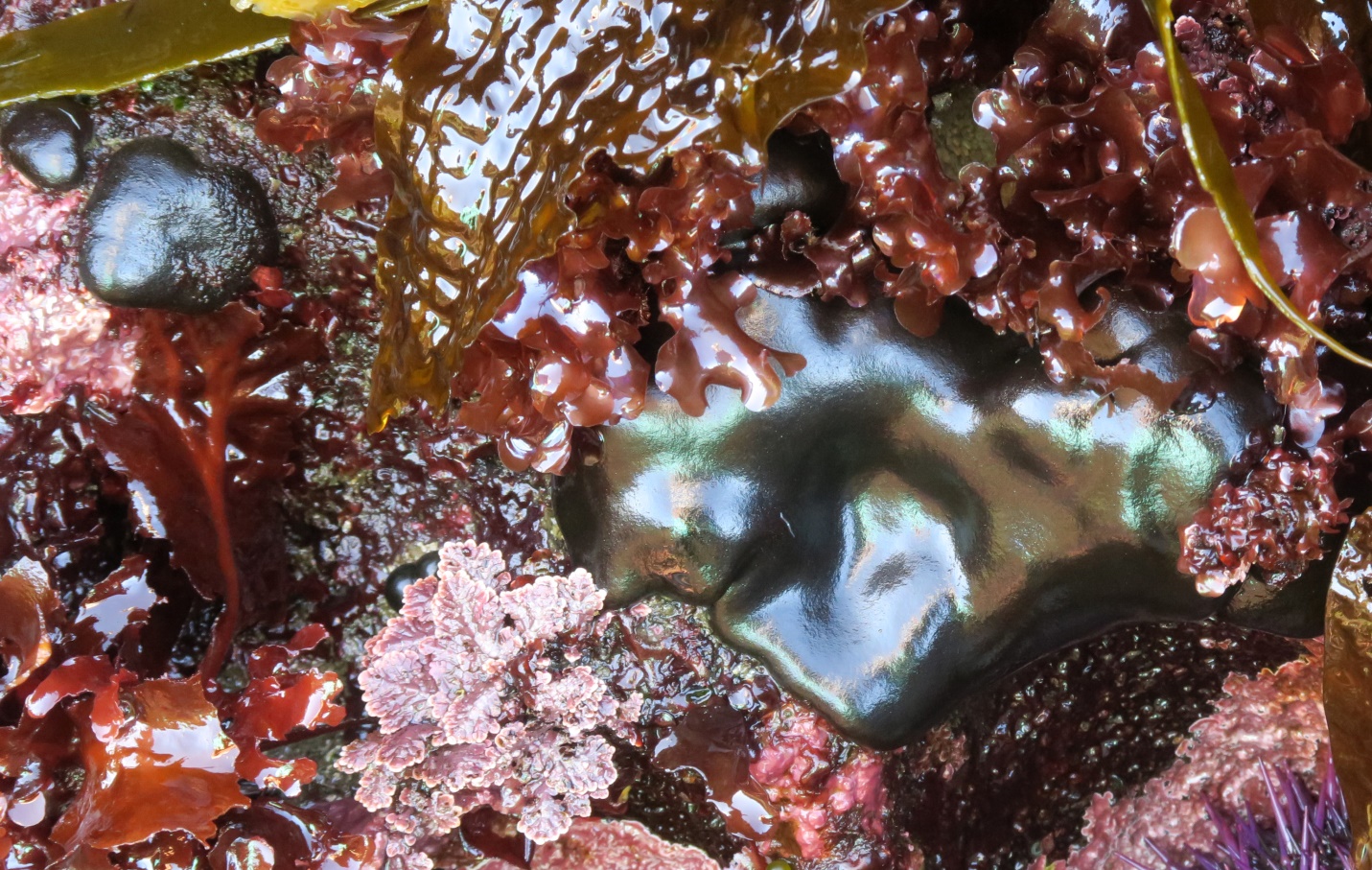
Figure 2: A closer view of Codium setchellii reveals its “looks”--- as one observe said, it “looks SORT OF like a crust”. Ranging from deep, dark green or almost black to pearly shining light green or nearly white when it reflects the light, once you find this seaweed, it makes an impression. Botany Bay, Juan de Fuca Strait, B.C., Canada. June 5, 2023. Photo ID 27592 ©Seaweedwhisperings.com
Person 2:
Deep, dark green.
Prominent in the shade, with a sheen that draws me in.
The sheen creates a span of looks from nearly white to nearly black.
It’s a tough position to inhabit that you choose, Codium setchellii, out on the protruding rim of the sandstone pits. On the rims, yes, but these rims are in an overall area that is very shaded.
You look soft and cushiony but many that I touch are hard, tough. In some individuals you have a bit of give and are somewhat “spongy”, but not much. There is a sense of strength in this quality. You will NOT be pushed out of place!
You do seek the shade (north facing ledge) and you thrive with other algae drooping over you – thereby providing you with even more shade.
You do not have a need to “show off” and seem averse to being “lit up” in full view, but once one ‘sees’ you, one can feel impressed, or, at least I am.
You have a quiet dignity, Codium setchellii – I would willingly follow you as my guide to the “almost” white and the “almost” black.
You engender my trust with unspoken hints, or is it GLINTS.., of your wisdom.
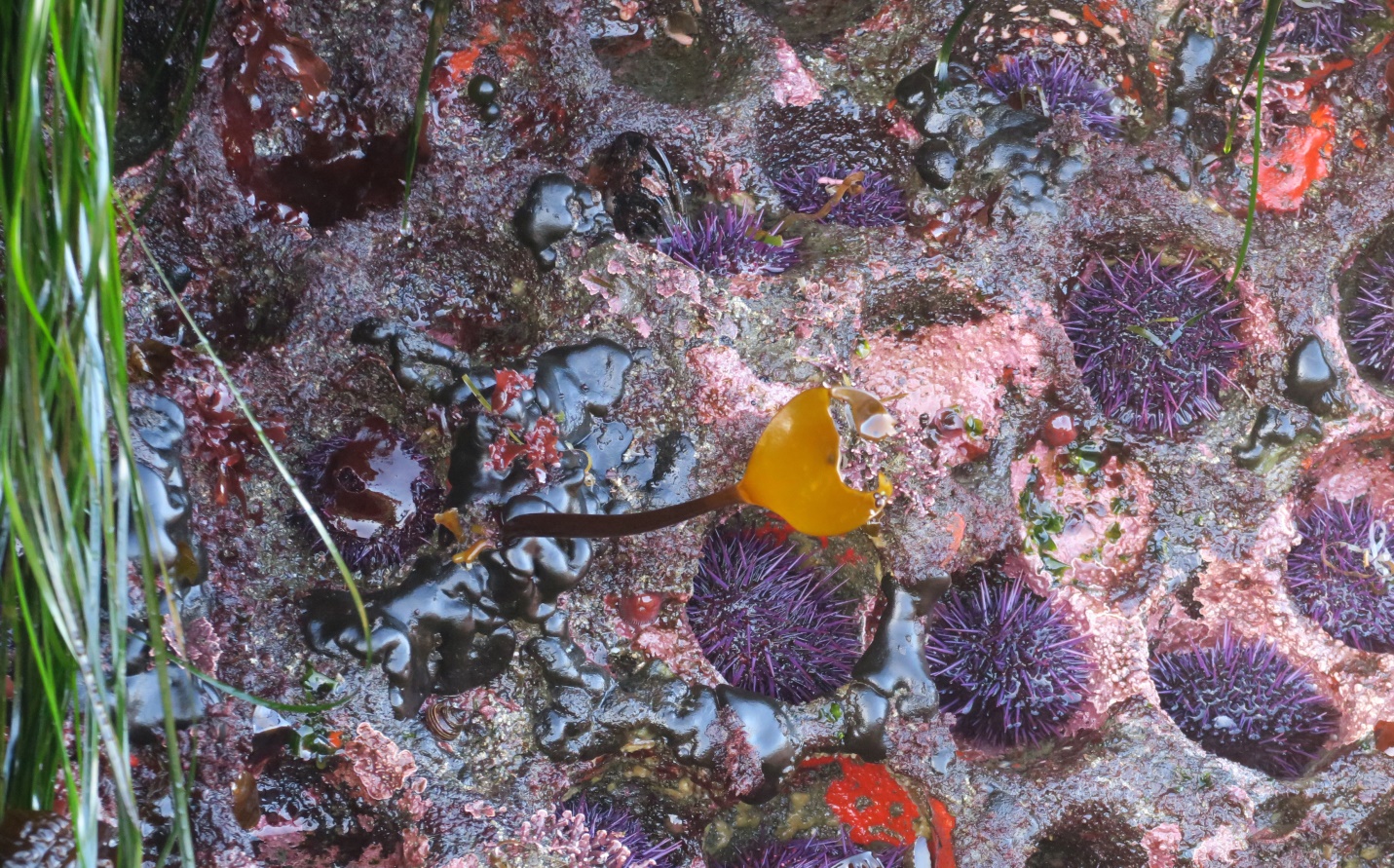
Figure 3: In this photo there are many “Green spongy cushions” growing. Unfortunately the photo ‘flattens’ what is easier to see in person, so it is hard to perceive that the Codium setchellii seaweed is mainly growing on the outermost ‘rims’ and the most protruding sections of the sandstone wall substrate – a wall of rock that is riddled here with “urchin-pits” (that are currently abundantly populated with purple urchins). The interesting sheen of this seaweed also helps it to almost hide in plain sight. Botany Bay, Juan de Fuca Strait, B.C., Canada. June 5, 2023. Photo ID 27593 ©Seaweedwhisperings.com
Person 3:
Unobtrusive but certain.
Soft but strong and protective.
It’s on a vertical rocky surface which I believe has a north exposure, so there’s low light, no sun. It appeared to me to be in a surge channel, but it wasn’t enjoying the water movement in the same way as the kelps.
I was struck by the first one I looked at that appeared to be rimming the sandstone ‘urchin-pit’ as if protecting the edge, so when other things bumped it (because it’s in a surge channel) they wouldn’t be damaged.
The overwhelming feeling I got was of a sense of protection – personal protection and a desire to personally protect.
Is this personal protection a kind of hiding? If so, what from?
This brought an element of uncertainty to my feeling about Codium setchellii.
The wall had a huge diversity of life forms, but it was overlooking a flatter area, which was relatively devoid of diversity. Is this relevant?
Perhaps not; more uncertainty creeping in.
Returning on a different day I realized that in doing the original interaction with this seaweed it was impossible (due to its location) to actually sit and observe the seaweed and make notes while considering its energy. You had to be willing to retain the information for recording later. However, today sitting on top of the rock shelf that creates the overhang and surge channel where this seaweed is growing, I felt as long as I acknowledged that it was there, all was good. Codium setchellii seemed to desire acknowledgment and would put effort into that, but once that was obtained no further effort was needed on its part; it was then content to do its thing.
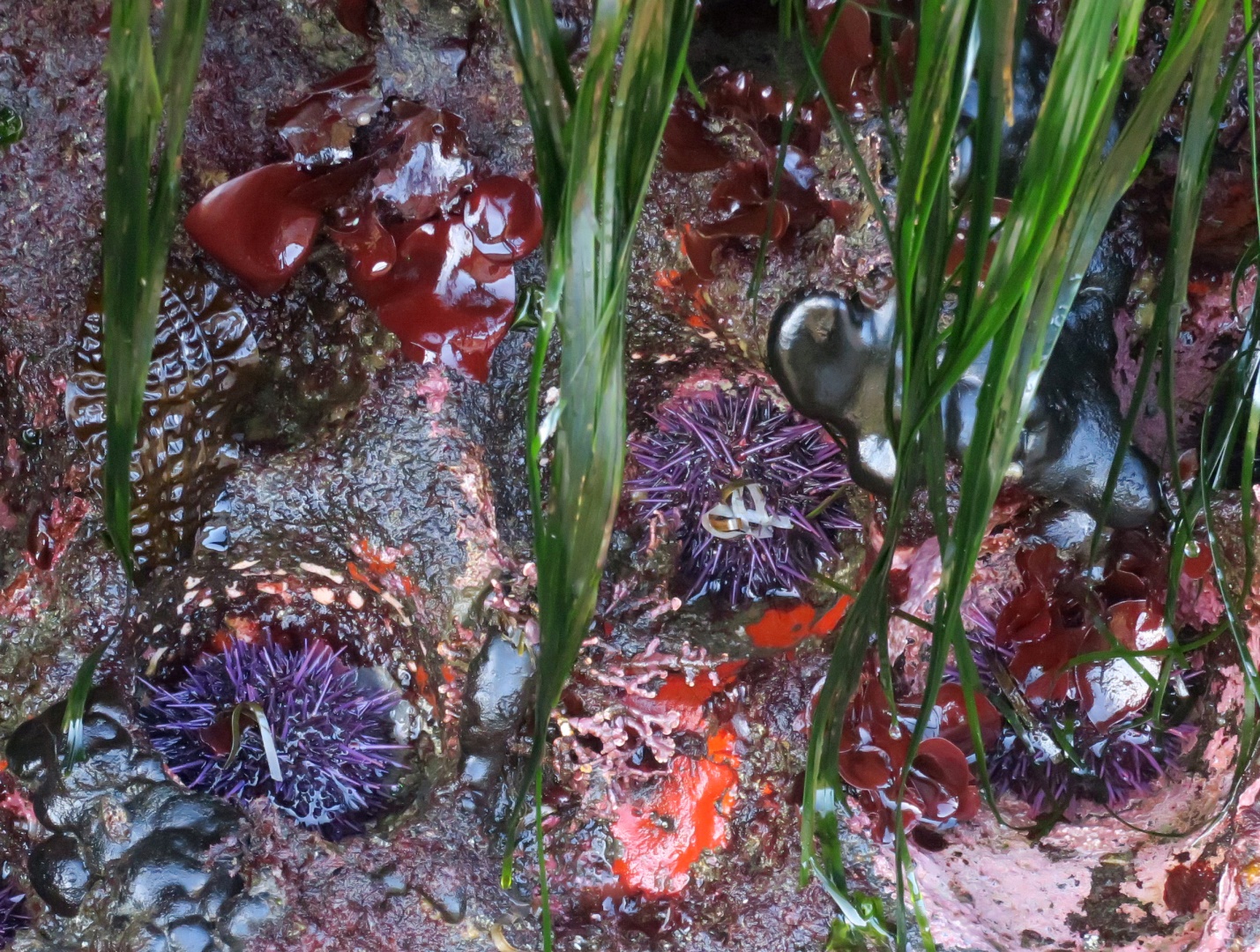
Figure 4: Hiding out – this photo shows how Codium setchellii enjoys inhabiting places of shadow and low light. Here many of the “Green spongy cushions” are partially hidden by overhanging strands of eel grass, and the entire rock wall itself is shaded by an overhang. Botany Bay, Juan de Fuca Strait, B.C., Canada. June 5, 2023. Photo ID 27594 ©Seaweedwhisperings.com
Discussion:
Deviousness..., Codium setchellii IS devious in a manner of speaking..., with the span of color from nearly white to nearly black, one person picked up the range of “looks” this seaweed can have. The synonyms of the noun “looks” include: manner, semblance, guise, façade. So with “looks” there can be a devious quality, or a manner in which to present as an imposter. Codium setchellii was also observed to “sort of” look like a crust. Again, the “looks” may not reveal the full ‘picture’ with this seaweed, or they may intentionally present only a certain part of the picture whilst omitting or obscuring other parts.
Having devious intentions or intentionally presenting as an imposter – these could be traits that one desires to keep hidden. And Codium setchellii certainly chooses to live in areas that are quite out of the way, quite difficult to find, places that are quite well and truly HIDDEN. We pondered this aspect..., why else might this seaweed desire to be so hidden, or feel the urge to live in hidden places?
Possibly it could be because they have some precious knowledge or skill and are therefore valuable to their group and worthy of special protection? Or could they be hiding because they have something of value, something that they fear might be “stolen” from them, and this “thing” is something they are not yet ready or willing to part with, except voluntarily and in ways totally chosen by them?
Hide..., again, why hide? Are they weak or too vulnerable in some way? They have a type of certainty to them and they also emit a sheen like a fine satin cloth or the luster of precious metals. Are they like some highly successful people, persons at “the top” of some human endeavor or organization or country who cannot remain at the top without the protection of a large support group of talented staff?
There is no doubt that Codium setchellii enjoys being far away from full light; it is clear that it prefers being hidden in the shadows. How did such a confident, certain and lustrous personality come to inhabit this almost contradictory life circumstance?
They are masterful and confident and lustrous, but they also are hidden away in the darkest places. It seems that they are at the peak, the summit, the very pinnacle of working with and living with low light. Somehow they got on the “low light” track and they mastered it; but now, well...., now they cannot actually come out of the low light!
Possibly they cannot be a master in any other way. And a master they are meant to be, so they stay in this position and even have assistants keeping them there (such as other seaweeds and seagrasses to help in shading them from strong light). There are many expressions or tracks of life one could be a master at. For this seaweed, it seems they are the “green” master of the shadows and the low light.
It seems that this could include being masterful at “hiding in the dark” and it could also include being masterful at holding or hiding or secreting wonders or concepts that they don’t want to fully share.
Possibly also, the “deception” trait relates to their own knowledge that their ‘wisdom’ is useful to a smaller audience than they’d prefer, and thus they ‘infer’ a breadth to their mastery that is not actually present.
At this level, the mastery level, one can become valuable or have value in a rather narrow segment of life. It seems that Codium setchellii has done just that – they are the master of something very narrow. There is, however, greatness in even this narrow mastery, because as Codium setchellii demonstrates, they can be masters in areas where success is truly very difficult to achieve.
This seaweed is a green algae; the “greens” are most typically opportunistic of seasonally opened up new territories and they are highly photophilic. Codium setchellii also thrives in light, but has adapted to living brilliantly with the type of light found only in very shady places. How can it do this? It’s become so good at making an abundance of chloroplasts that even in very low light it can thrive! Possibly also when one is full of so many chloroplasts, exposure to large amounts of direct sunlight would quite dangerously overload the photosynthetic formula, resulting in a catastrophic failure, and along with that, they would also suffer an emptying out and loss of all their mastery.
What an unusual mastery this is for one of the world’s green algae. And do take note, with its traits of deception and hiding, one must also look in unusual places to have a chance of making an acquaintance with this remarkable seaweed.
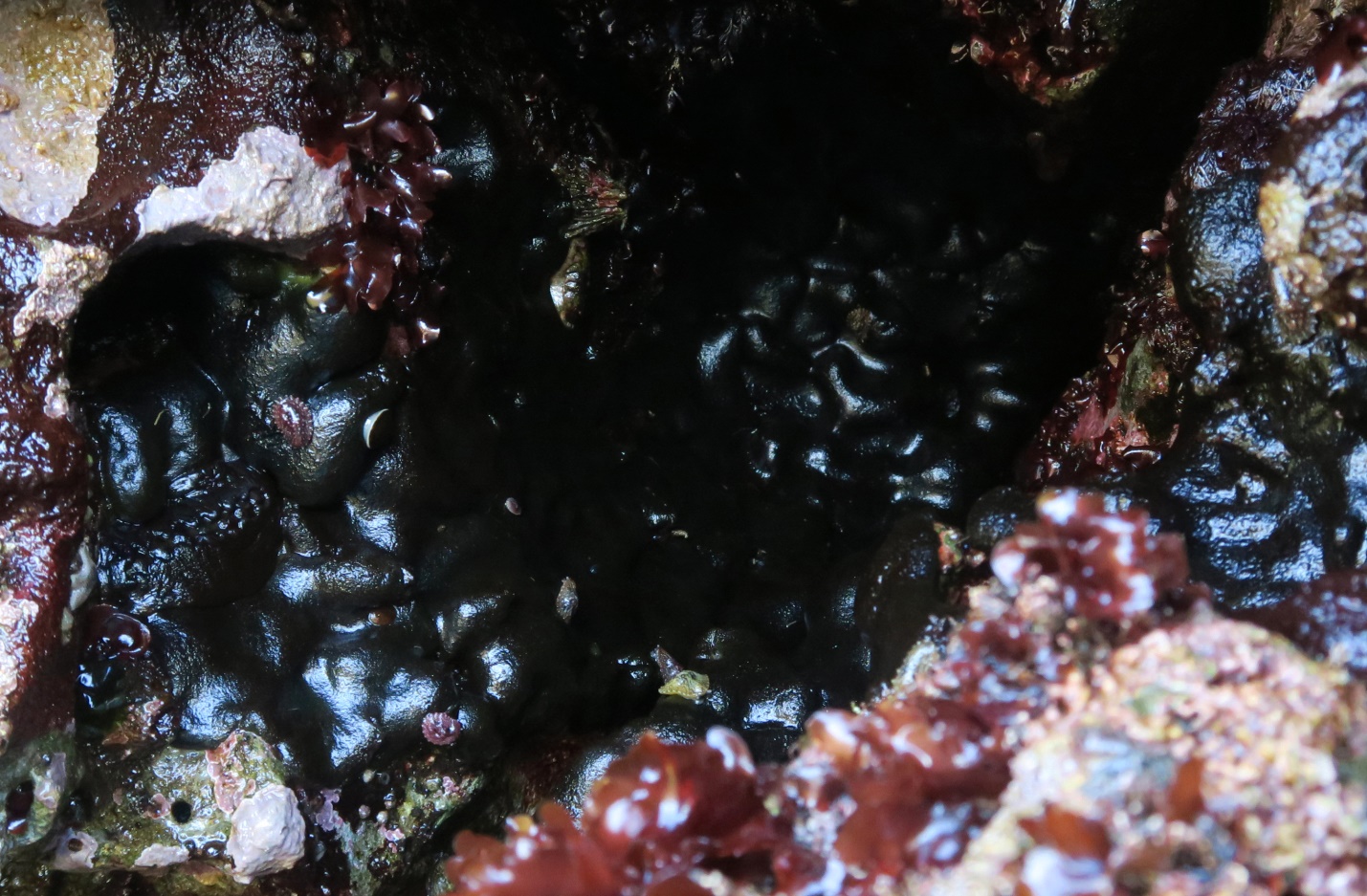
Figure 5: In a crevice and on the shaded side of a large intertidal boulder, a thick “crust” of Coldium setchellii can be seen here in its almost black colored form. A good variety of chitons, limpets and snails can be seen on the surface of this unusual green algae – they are likely grazing and the deep green Codium setchellii is chloroplast rich – so it is a very good meal indeed for many such animals. Botany Bay, Juan de Fuca Strait, B.C., Canada. May 29, 2021. Photo ID 27595 ©Seaweedwhisperings.com
Biology & Natural History Information:
Description:
Thallus is a dark green, thick, spongy crust 25 cm (10 in) or more in diameter and 15 mm (0.6 in) or less thick. The overall appearance is of a rounded, irregularly shaped velvety-looking cushion. Color can range from dark green to almost black. Because the filaments of the thallus are narrow, the tips are not visible to the naked eye and the surface appears smooth. The texture of this alga changes from firm to spongy as it ages.
Habitat:
This perennial occurs on rock in the very low intertidal or shallow subtidal of semi-exposed and exposed coasts.
North Pacific Distribution:
Northern Southeast Alaska (Chichagof Island) to Baja California, Mexico.
Remarks:
Several species of sacoglossan sea slugs, nicknamed the “solar powered sea slugs” or “sap sucking sea slugs”, occur on and eat Codium and Bryopsis algae – species of these two green algae genera are found in the lowest of the intertidal regions inhabited by green seaweeds. One of these sea slugs, Elysia chlorotica, is able to retain functional chloroplasts after it sucks them out of the green algae; the chloroplasts carry on photosynthesis for several days inside the animal’s digestive apparatus. This ability/relationship (using chloroplasts from algae they have consumed that continue to produce energy for the animal via photosynthesis) is called kleptoplasty.
This species was named for William A. Setchell, a phycologist at the University of California in the late 1800’s and early 1900’s.
Classification:
Phylum: Chlorophyta
Class: Ulvophyceae
Order: Bryopsidales
Family: Codiaceae
Genus: Codium
Species: Codium setchellii N.L.Gardner 1919
Former Name(s): Codium adhaerens var. incrassatum Dellow 1952
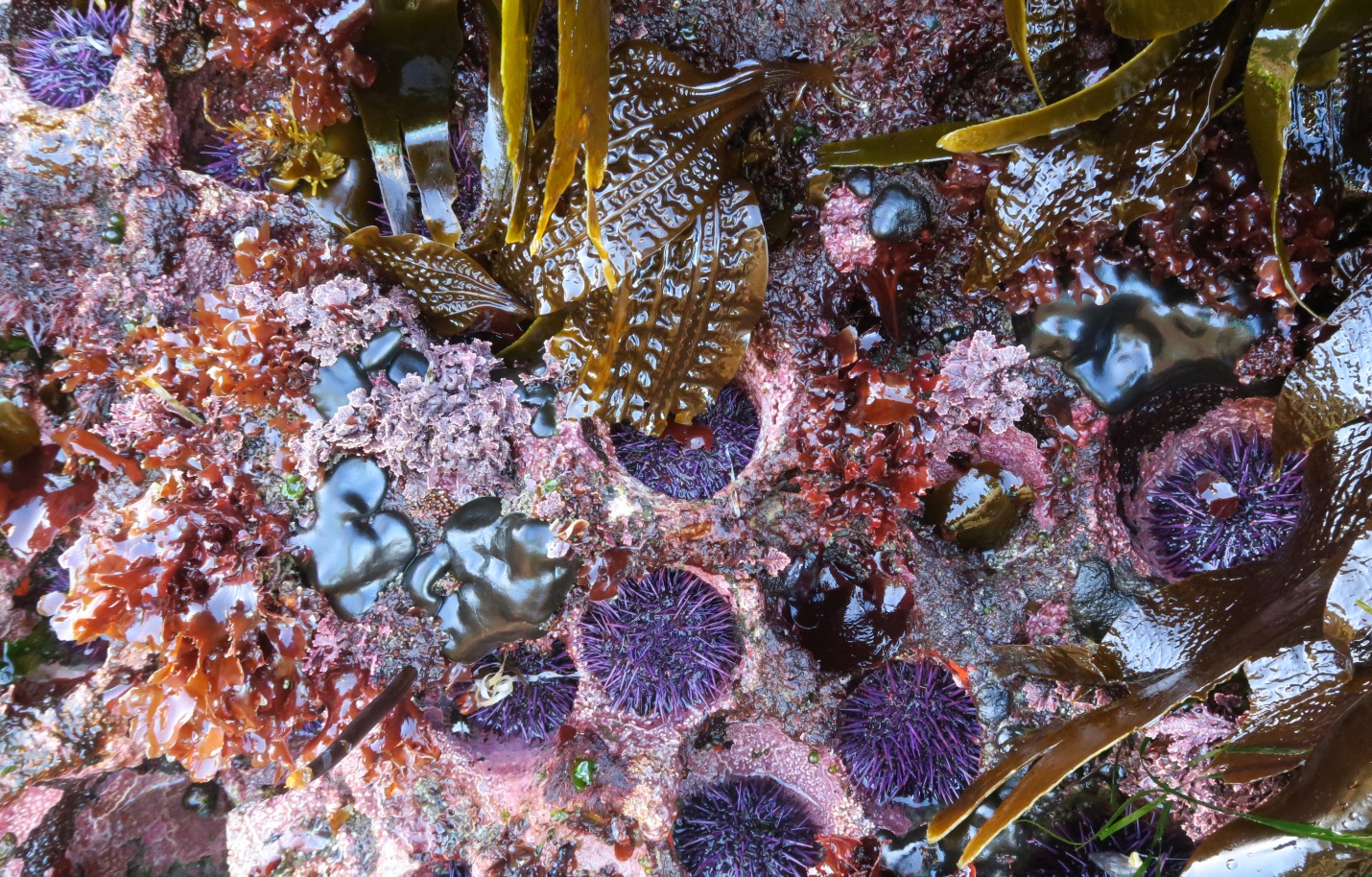
Figure 6: Another view of the Codium setchellii algae ‘crusts’ growing in numerous spots on this richly inhabited intertidal substrate. Botany Bay, Juan de Fuca Strait, B.C., Canada. June 5, 2023. Photo ID 27596 ©Seaweedwhisperings.com
![]()